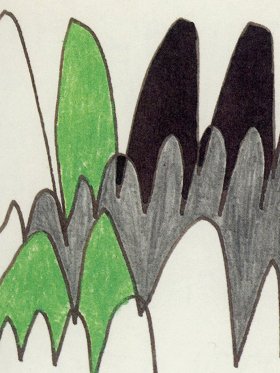‘It’s silly, no?
When a rocket ship explodes and everybody still wants to fly’.
— Prince, ‘Sign O’ The Times’
This text conjures up a voyage, a ‘theory-fiction’ that leads the reader to the Anthropocene, the new geological age. The fiction begins with a well-known character, recognizable by his yellow head of hair and his tweets, and ends with a fantasy where a reinvented Marx is the author of a critique of political astronomy.

Rui Toscano, Pequena Nebulosa #8, 2015
Courtesy of the artist and Cristina Guerra Contemporary Art
Earth Zoom-out (Prologue)
Yellow.
At first, that’s all you can see, nothing but yellow.
Then you realize that the colour is actually a head of hair crowning a real-estate mogul who has acquired the capability of launching tweets and nuclear warheads. At the same latitude, one can make out the appearance of an unstable confederation of despots backlit by shale gas, adjusting their carbon footprints in accordance with their scheduled torture sessions; among them, newly elected democrats establish their expertise by codifying the disappearance of the people and by creating for themselves the status of demospots and offering a state of exception to suicide bombers in runaway trucks.
Surrounding those in charge, one can clearly make out nationalist groups, using rural zones as support bases; white with fright, who, through such sites as originaryecho. org confirm and curse the existence of the ‘privileged’ among us. Namely: ‘all those who enjoy having not been completely and immediately destroyed by capitalism’ — or, according to another perspective, ‘any individual who has taken up the belief that only an individuality that has achieved some sort of professional success would be capable of escaping a total liquidation’ (metasociology.org) ; or, alternatively, ‘those who bear the half-faded stigma of a knowledge reminding us of what must have been forgotten so as to have fallen so far down’ (leftlacan.org).
A bit higher in your ascent, you can begin to make out other territories: valleys of silicon, devastated forests, cities aglow overlooking fields of processed food-stuffs; urban and rural zones that become blurred residential areas for a billion of individuals living in shanty towns where not even Diogenes feels the slightest public outrage; in half-vacant spaces left abandoned by the administrative machinery, one can see autonomous communities and ephemeral Communes, interconnected yurts, minds plunging into the dirt with their hands for the first time, anarchists making alliances with trees — all of them striving to save the honor of terrestrial politics. Minoritarian, they converse with the interstitial groups who survive in spite of the continuing development and gentrification of the cityscapes.
You advance a bit higher up still, and you see planes skipping across clouds over eroded mountainsides and oceans bloated with plastic. You carefully avoid at all costs the satellites and technological waste floating in the upper atmosphere, forever caught within geo-stationary orbit or which finally crashing into Point Nemo. You can finally contemplate the Earth as it appears at the bottom of your screen: AS17-148-22727, the famous Blue Marble, the image captured by Apollo 17 on December 7, 1972. But already Earth is falling back in the distance, the Moon and then the other planets slip right past you, and you find yourself beyond Neptune, traversing the Kuiper Belt, you leave the heliosphere and you make your way out into interstellar space, then you traverse the Oort Cloud, two light-years from the Sun. You venture outside the Milky Way, you move beyond the Local Group of Galaxies, you make your way past the Virgo Supercluster, you venture beyond the Local Supercluster (Laniakea) that stubbornly drifts and scatters, recalcitrant to any gravitational unification.
You’ve done it. You have escaped.
You are lost in the middle of nowhere.
You have finally experienced the ultimate background zoom: a progressive distancing from the Earth all the way to the limits of the universe.
You have left behind the hegemonic politics that has a firm grip on the Earth — the democracy of the economy, the religion of scorched Earth — so you can plunge yourself into what is the most distant, the most inhuman. And you don’t necessarily have any desire to return.
"If we must define our epoch, then it will be necessary to simultaneously consider these three meanings or directions of Time: that which is derived from human history; the articulation of this history regarding geological temporality; and the way in which this temporality refers to an astronomical outside."
How to Go from the Depths of the Universe to Marx?
The theory-fiction voyage that I just proposed transports along with it a representation that is, alas, already widespread: considering the inhuman as something that we can only encounter by way of an outside freed from the zone of psycho-ontological security, as an immoral element, or as materiality that is radically distanced from human ‘nature’. Though what would happen if we decided to invert the topology of the inhuman? What if the outside was actually that which was the closest to us? In truth, the Local Supercluster or Lakinea (the Hawaiian term for Immense Heaven), is not some far away structure, we are already in it, and we are made of it! The Local Supercluster must be recognized as the extraterrestrial dimension that opens the Earth to its Outside. But how can we continue to support and promote this opening? And in what way can this opening allow us to respond to the political stakes that are most certainly earthly regarding what we can call a generalized exhaustion — an exhaustion that, as I tried to show in this prologue is both democratic as well as environmental?
What my present essay is attempting is to think and gather together what seems to be the most disjointed and most distant: the terrestrial and the extra- terrestrial, the environmental and the astronomical, the political and the cosmological. My hypothesis is that the meeting point between these domains is geological. It’s by way of the politicization of the geological — a ‘politics of strata’ (Nigel Clark) — that the relation between here and the far away will be established. I will name this encounter Deep Marx: an encounter between, on the one hand, the deep time discovered by geology — a temporality that in the end exceeds its geological dimension and thus opens itself up to astronomical time, the time of the Earth plunged into the universe — and, on the other hand, a politics aiming to identify and interrupt the destructive extraction that is the foundation of the Anthropocene. In other words, a politics capable of responding without delay to the environmental damage produced by capitalism. IBM has its Deep Blue. Hollywood already had its Deep Impact — our era is in need of its Deep Marx.
[...]
*Translated by Drew Burk





Share article